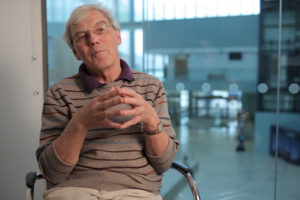Electron Cryomicroscopy
Molecular Biologist Richard Henderson on blobology, 2D crystals, and the resolution revolution
Motor neurons are amongst the largest cells in the body: typically, they have a diameter of 20 or 30 microns, and in the case of motor neurons in your spinal cord, which innervate the muscles in your foot, maybe up to a meter long. So these are cells which are really rather unusual and remarkable. If we compare them to a simple blood cell, lymphocyte which is a sort of ovoid or spherical structure of 10 microns where the nucleus and the cytoplasm are in close apposition, it doesn’t have any polarity, a motor neuron is the opposite: it’s highly polar, the synapse is very distant from the cell body in the nucleus.
And the question arises as to how such a cell can even function in the first place. Clearly, for messages or responses to biological perturbations which might require the expression of genes in the nucleus, how does that then result in protein changes at the synapse, which may be a meter away in a healthy grown adult? So that requires extremely well-organized axonal transport, and we know that even so-called fast axonal transport occurs really at a rate, which means that protein produced in the cytoplasm near the nucleus may take several days to arrive at the synapse. So if there’s an acute injury to the synapse, it’s not really that plausible that this is going to be able to maintain the homeostasis of a synapse.
A strikingly interesting thing about that is that genetic disorders of the motor neuron turn out to include things that arise through mutation in RNA-binding proteins. Perhaps the first example of this is spinal muscular atrophy. I have been working on that for more than 20 years, and spinal muscular atrophy is a predominantly childhood disorder in which only lower motor neurons, those motion neurons that are in the spinal cord, are affected. It, in its most severe form, leads to death within a year or two from respiratory failure at so-called type-1 SMA, which was historically known as Werdnig–Hoffmann disease.
But we now know that there are other forms of SMA, which essentially are due to mutations in the same gene, and these cause mild diseases that shouldn’t survive past infancy and into adulthood.
It’s actually one of the commoner genetic disorders, one in 40 people carry a genetic deletion of a gene called SMN which stands for survival of motor neurons.
This gene, if deleted out in two copies, one on each chromosome, chromosome five, leads to a deficiency of the protein, and motor neurons clearly have a requirement for that protein, which other cells don’t. It’s probably locked into their development when they’re innervating muscle.
An important concept that’s helpful in considering motor neurons in their architecture is the motor unit. So in the ventral horn of your spinal cord, the cell body is there, the motor neuron, its axon goes out into the limb, the neuromuscular junctions that arise from that and the individual muscle fibres are the motor unit. So, one motor neuron innervates multiple muscle fibres typically, but that motor unit varies hugely. The motor unit of muscles which are in your trunk, for example, for posture, may include 200-300 fibres innervated by one motor neuron. The motor unit in your eye, extraocular muscles, which are tonically active at high frequency, may include only two or three individual muscle fibres, so quite different architectures, different energetics and different biology.
Why these cells are protected is the source of some interest. No one’s really worked it out yet, and the assumption is that there’s something in the cell which is biologically different. For example, there are calcium buffering proteins which are different in extraocular motor neurons compared to spinal motor neurons, but it may be the whole architecture that’s different about it. For example, eye movements are finer genetically and much more ancient than other sorts of movement. That brings the interesting question of evolution and how that has rendered this system vulnerable. For example, if you look at different species and look at the corticospinal tract, the fibres from the motor cortex down into the spinal cord, humans have about 1.1 million fibres of this tract. It turns out that chimpanzees, a very closely related primate to us, have 800,000. So we have significantly more of these fibres, and many of these fibres exert a one-to-one relationship between a cortical motion neuron and a spiral motion neuron with direct synaptic contact, whereas in other species, typically, this goes via interneurons. So it’s a completely different system, and there’s a more direct and perhaps excited toxic potential for these fibres to cause damage.
The likelihood is that this has arisen in evolution because of manual dexterity principally, and it allows very precise movement of the hands to play Beethoven or Schubert, and that dexterity distinguishes human beings. But that may come with a certain vulnerability, and it may be that this whole system is vulnerable because in recent evolution it’s evolved rather rapidly, and there’s a sort of penalty to pay in a few cases as an inherent vulnerability.
So motor neurons have a specific set of cellular vulnerabilities, they have a complex architecture, and diseases arise, which are purely motion neuron diseases that tell you they’re rather distinctive cells.
For the future, what we really need to understand is more about the subtypes of motor neurons, so we look down the microscope at the spinal cord, and we basically classify them on their size and their appearance, morphological criteria. What we know now is that if you use single-cell transcriptomics, for example, you can pull out many, many different types of neurons in any area of the brain. So, the repertoire of neuronal function based on transcriptomic profiling will reveal whole new patterns of function and susceptibility to disease in the future, which will be very important in understanding biology because, in most of these disorders, there is a differential vulnerability. In spinal muscular atrophy, for example, it’s the proximal muscles which are involved less than the distal muscle. So, understanding the individual transcriptomics will ultimately allow us to understand more about how these cells function.
We don’t really understand very well how cells are organized in a circuit in the spinal cord. So, the motor output, which determines the pattern of movement, is very complex, and there are automatic sorts of output, for example, from walking and posture. And then there are much more specific outputs which are under conscious control to a much greater degree, such as dexterity. So exactly the way in which these outputs are patterned in the spinal cord is not well understood, and actually, that may be an important way in which ways they function, in which they fail.

Molecular Biologist Richard Henderson on blobology, 2D crystals, and the resolution revolution

Physicist Jonathan Butterworth on the collisions of particles, the Large Hadron Collider detectors, and how to...

Cognitive neuroscientist Patrick Haggard on the Pacinian corpuscle, three attributes of the tactile sensations...